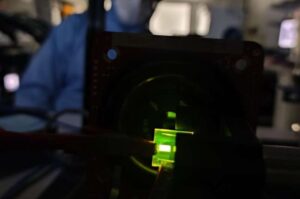
Researchers at the University of Oxford have made a groundbreaking advancement in organic light-emitting diodes (OLEDs). For the first time, they have developed a method to electrically switch OLEDs to emit either left- or right-handed circularly polarized light, all without altering the light-emitting molecules themselves. This innovation, detailed in a study published in Nature Photonics, could have significant implications for various technological applications, including more energy-efficient displays and improved optical information transmission.
Understanding Light Polarization in OLEDs
Traditionally, the handedness of circularly polarized light emitted by OLEDs is controlled by selecting specific mirror-image forms of light-emitting molecules. These forms, known as chiral molecules, can be likened to choosing a corkscrew that twists to the left or right. Each handedness corresponds to a distinct light type, necessitating access to both forms of the molecule, which can be intricate and costly to produce.
In this latest study, the research team demonstrated that both left- and right-handed circularly polarized light can be generated using only one mirror form of the molecule. They achieved this by designing emitting materials that exhibit unique effects on circularly polarized light, alongside precise management of electronic charge recombination within the device. By balancing or unbalancing charge transport, the researchers could switch the handedness of the emitted light.
Key to this breakthrough is the use of an organic polymeric emitting material that self-assembles into a highly twisted structure, allowing for this new mechanism of control.
Potential Applications and Future Implications
The ability to control light polarization is particularly relevant for advancements in low-power displays, encrypted communication systems, and high-performance quantum technologies. Professor Matthew Fuchter, the lead author of the study, notes, “Adding circular polarization allows for additional information to be encoded into the light signal. Rather than your signal being simply ‘on’ or ‘off,’ it could additionally be ‘on-and-left’ or ‘on-and-right.'”
Previous methods for managing OLED light circular polarization involved separating different handed forms of the same molecule, a process that is labor-intensive, expensive, and not easily scalable. The new approach marks a significant shift in the way circularly polarized LEDs can be created, offering a more practical solution.
Moreover, this study uncovers fundamental connections between molecular chirality and light chirality, often referred to as optical activity. The research team anticipates that these insights into the physics of chiral organic materials will pave the way for innovative applications in advanced displays, secure communication systems, and quantum technologies.
For more details, the full study is available in Nature Photonics (DOI: 10.1038/s41566-025-01780-4).







